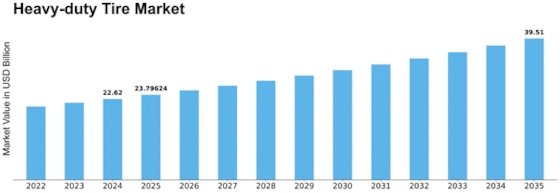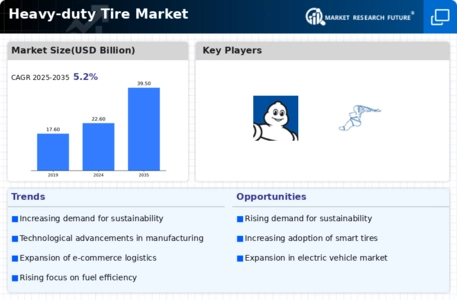-
Executive summary
-
Market IntroductioN
-
Definition
-
Scope of the Study
- Research Objective
- Assumptions
- Limitations
-
Research Methodology
-
Overview
-
Data Mining
-
Secondary Research
-
Primary Research
- Primary Interviews and Information Gathering Process
- Breakdown of Primary Respondents
-
Forecasting Model
-
Market Size Estimation
- Bottom-Up Approach
- Top-Down Approach
-
Data Triangulation
-
Validation
-
Market Dynamics
-
Overview
-
Drivers
-
Restraints
-
Opportunities
-
Market Factor Analysis
-
Value Chain Analysis
-
Porter’s Five Forces Analysis
- Bargaining Power of Suppliers
- Bargaining Power of Buyers
- Threat of New Entrants
- Threat of Substitutes
- Intensity of Rivalry
-
COVID-19 Impact Analysis
- Market Impact Analysis
- Regional Impact
- Opportunity and Threat Analysis
-
GLOBAL HEAVY-DUTY TIRE MARKET, BY VEHICLE TYPE
-
Overview
-
Construction Machinery
-
Mining Machinery
-
Agricultural Machinery
-
Industrial Vehicles
-
GLOBAL HEAVY-DUTY TIRE MARKET, BY END-USER
-
Overview
-
OEM
-
Aftermarket
-
GLOBAL HEAVY-DUTY TIRE MARKET, by Region
-
Overview
-
North America
- US
- Canada
-
Europe
- Germany
- France
- UK
- Italy
- Spain
- Rest of Europe
-
Asia-Pacific
- China
- India
- Japan
- South Korea
- Australia
- Rest of Asia-Pacific
-
Rest of the World
- Middle East
- Africa
- Latin America
-
Competitive Landscape
-
Overview
-
Competitive Analysis
-
Market Share Analysis
-
Major Growth Strategy in the Global Heavy-duty Tire Market,
-
Competitive Benchmarking
-
Leading Players in Terms of Number of Developments in the Global Heavy-duty Tire Market,
-
Key developments and Growth Strategies
- New Product Launch/Service Deployment
- Merger & Acquisitions
- Joint Ventures
-
Major Players Financial Matrix
- Sales & Operating Income, 2022
- Major Players R&D Expenditure. 2022
-
Company ProfileS
-
Bridgestone Corporation
- Company Overview
- Financial Overview
- Products Offered
- Key Developments
- SWOT Analysis
- Key Strategies
-
Continental Tires
- Company Overview
- Financial Overview
- Products Offered
- Key Developments
- SWOT Analysis
- Key Strategies
-
BALKRISHNA INDUSTRIES LIMITED (BKT)
- Company Overview
- Financial Overview
- Products Offered
- Key Developments
- SWOT Analysis
- Key Strategies
-
Michelin
- Company Overview
- Financial Overview
- Products Offered
- Key Developments
- SWOT Analysis
- Key Strategies
-
Titan Tire Corporation
- Company Overview
- Financial Overview
- Products Offered
- Key Developments
- SWOT Analysis
- Key Strategies
-
Sumitomo Rubber Industries, Ltd
- Company Overview
- Financial Overview
- Products Offered
- Key Developments
- SWOT Analysis
- Key Strategies
-
Trelleborg AB
- Company Overview
- Financial Overview
- Products Offered
- Key Developments
- SWOT Analysis
- Key Strategies
-
The Goodyear Tire & Rubber Company
- Company Overview
- Financial Overview
- Products Offered
- Key Developments
- SWOT Analysis
- Key Strategies
-
JK Tyre & Industries Ltd
- Company Overview
- Financial Overview
- Products Offered
- Key Developments
- SWOT Analysis
- Key Strategies
-
Appendix
-
References
-
Related Reports
-
LIST OF TABLES
-
Global Heavy-duty Tire Market, Synopsis, 2018-2032
-
Global Heavy-duty Tire Market, Estimates & Forecast, 2018-2032 (USD BILLION)
-
GLOBAL HEAVY-DUTY TIRE MARKET, BY Vehicle Type, 2018-2032 (USD BILLION)
-
GLOBAL HEAVY-DUTY TIRE MARKET, BY End-user, 2018-2032 (USD BILLION)
-
North America: HEAVY-DUTY TIRE MARKET, BY Vehicle Type, 2018-2032 (USD BILLION)
-
North America: HEAVY-DUTY TIRE MARKET, BY End-user, 2018-2032 (USD BILLION)
-
US: HEAVY-DUTY TIRE MARKET, BY Vehicle Type, 2018-2032 (USD BILLION)
-
US: HEAVY-DUTY TIRE MARKET, BY End-user, 2018-2032 (USD BILLION)
-
Canada: HEAVY-DUTY TIRE MARKET, BY Vehicle Type, 2018-2032 (USD BILLION)
-
Canada: HEAVY-DUTY TIRE MARKET, BY End-user, 2018-2032 (USD BILLION)
-
Europe: HEAVY-DUTY TIRE MARKET, BY Vehicle Type, 2018-2032 (USD BILLION)
-
Europe: HEAVY-DUTY TIRE MARKET, BY End-user, 2018-2032 (USD BILLION)
-
germany: HEAVY-DUTY TIRE MARKET, BY Vehicle Type, 2018-2032 (USD BILLION)
-
germany: HEAVY-DUTY TIRE MARKET, BY End-user, 2018-2032 (USD BILLION)
-
FRANCE: HEAVY-DUTY TIRE MARKET, BY Vehicle Type, 2018-2032 (USD BILLION)
-
FRANCE: HEAVY-DUTY TIRE MARKET, BY End-user, 2018-2032 (USD BILLION)
-
italy: HEAVY-DUTY TIRE MARKET, BY Vehicle Type, 2018-2032 (USD BILLION)
-
italy: HEAVY-DUTY TIRE MARKET, BY End-user, 2018-2032 (USD BILLION)
-
spain: HEAVY-DUTY TIRE MARKET, BY Vehicle Type, 2018-2032 (USD BILLION)
-
spain: HEAVY-DUTY TIRE MARKET, BY End-user, 2018-2032 (USD BILLION)
-
UK: HEAVY-DUTY TIRE MARKET, BY Vehicle Type, 2018-2032 (USD BILLION)
-
UK: HEAVY-DUTY TIRE MARKET, BY End-user, 2018-2032 (USD BILLION)
-
rest of europe: HEAVY-DUTY TIRE MARKET, BY Vehicle Type, 2018-2032 (USD BILLION)
-
rest of europe: HEAVY-DUTY TIRE MARKET, BY End-user, 2018-2032 (USD BILLION)
-
Asia-Pacific: HEAVY-DUTY TIRE MARKET, BY Vehicle Type, 2018-2032 (USD BILLION)
-
Asia-Pacific: HEAVY-DUTY TIRE MARKET, BY End-user, 2018-2032 (USD BILLION)
-
japan: HEAVY-DUTY TIRE MARKET, BY Vehicle Type, 2018-2032 (USD BILLION)
-
japan: HEAVY-DUTY TIRE MARKET, BY End-user, 2018-2032 (USD BILLION)
-
china: HEAVY-DUTY TIRE MARKET, BY Vehicle Type, 2018-2032 (USD BILLION)
-
china: HEAVY-DUTY TIRE MARKET, BY End-user, 2018-2032 (USD BILLION)
-
india: HEAVY-DUTY TIRE MARKET, BY Vehicle Type, 2018-2032 (USD BILLION)
-
india: HEAVY-DUTY TIRE MARKET, BY End-user, 2018-2032 (USD BILLION)
-
australia: HEAVY-DUTY TIRE MARKET, BY Vehicle Type, 2018-2032 (USD BILLION)
-
australia: HEAVY-DUTY TIRE MARKET, BY End-user, 2018-2032 (USD BILLION)
-
south korea: HEAVY-DUTY TIRE MARKET, BY Vehicle Type, 2018-2032 (USD BILLION)
-
south korea: HEAVY-DUTY TIRE MARKET, BY End-user, 2018-2032 (USD BILLION)
-
rest of asia-pacific: HEAVY-DUTY TIRE MARKET, BY Vehicle Type, 2018-2032 (USD BILLION)
-
rest of asia-pacific: HEAVY-DUTY TIRE MARKET, BY End-user, 2018-2032 (USD BILLION)
-
rest of the world: HEAVY-DUTY TIRE MARKET, BY Vehicle Type, 2018-2032 (USD BILLION)
-
rest of the world: HEAVY-DUTY TIRE MARKET, BY End-user, 2018-2032 (USD BILLION)
-
Middle east: HEAVY-DUTY TIRE MARKET, BY Vehicle Type, 2018-2032 (USD BILLION)
-
Middle east: HEAVY-DUTY TIRE MARKET, BY End-user, 2018-2032 (USD BILLION)
-
Africa: HEAVY-DUTY TIRE MARKET, BY Vehicle Type, 2018-2032 (USD BILLION)
-
Africa: HEAVY-DUTY TIRE MARKET, BY End-user, 2018-2032 (USD BILLION)
-
Latin america: HEAVY-DUTY TIRE MARKET, BY Vehicle Type, 2018-2032 (USD BILLION)
-
Latin america: HEAVY-DUTY TIRE MARKET, BY End-user, 2018-2032 (USD BILLION)
-
LIST OF FIGURES
-
Research Process
-
Market Structure for the Global HEAVY-DUTY TIRE Market
-
Market Dynamics for the Global HEAVY-DUTY TIRE Market
-
Global HEAVY-DUTY TIRE Market, Share (%), BY Vehicle Type, 2022
-
Global HEAVY-DUTY TIRE Market, Share (%), BY End-user, 2022
-
Global HEAVY-DUTY TIRE Market, Share (%), by Region, 2022
-
north AMERICA: HEAVY-DUTY TIRE MARKET, SHARE (%), BY REGION, 2022
-
Europe: HEAVY-DUTY TIRE MARKET, SHARE (%), BY REGION, 2022
-
Asia-Pacific: HEAVY-DUTY TIRE MARKET, SHARE (%), BY REGION, 2022
-
Rest of the world: HEAVY-DUTY TIRE MARKET, SHARE (%), BY REGION, 2022
-
Global HEAVY-DUTY TIRE Market: Company Share Analysis, 2022 (%)
-
Bridgestone Corporation: FINANCIAL OVERVIEW SNAPSHOT
-
Bridgestone Corporation: SWOT ANALYSIS
-
Continental Tires: FINANCIAL OVERVIEW SNAPSHOT
-
Continental Tires: SWOT ANALYSIS
-
BALKRISHNA INDUSTRIES LIMITED (BKT): FINANCIAL OVERVIEW SNAPSHOT
-
BALKRISHNA INDUSTRIES LIMITED (BKT): SWOT ANALYSIS
-
Michelin: FINANCIAL OVERVIEW SNAPSHOT
-
Michelin: SWOT ANALYSIS
-
Titan Tire Corporation: FINANCIAL OVERVIEW SNAPSHOT
-
Titan Tire Corporation: SWOT ANALYSIS
-
Sumitomo Rubber Industries, Ltd: FINANCIAL OVERVIEW SNAPSHOT
-
Sumitomo Rubber Industries, Ltd: SWOT ANALYSIS
-
Trelleborg AB: FINANCIAL OVERVIEW SNAPSHOT
-
Trelleborg AB: SWOT ANALYSIS
-
The Goodyear Tire & Rubber Company: FINANCIAL OVERVIEW SNAPSHOT
-
The Goodyear Tire & Rubber Company: SWOT ANALYSIS
-
JK Tyre & Industries Ltd: FINANCIAL OVERVIEW SNAPSHOT
-
JK Tyre & Industries Ltd: SWOT ANALYSIS










Leave a Comment